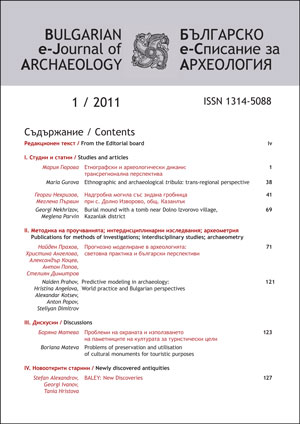Прогнозно моделиране в археологията: световна практика и български перспективи
Predictive modeling in archaeology: World practice and Bulgarian perspectives
Author(s): Nayden Prahov, Hristina Angelova, Alexander Kotsev, Anton Popov, Stelian DimitrovSubject(s): History, Archaeology
Published by: Асоциация на българските археолози
Summary/Abstract: In 2009, the Center for Underwater Archaeology has started a project on the Development of Predictive Models for Identification of Archaeological Sites along the Bulgarian Black Sea Coast in GIS environment, financed by the National Scientific Fund. This is the first major project in Bulgaria aimed at archaeological predictive modeling as a method to evaluate the probability of finding of archaeological sites within a specific territory and an attempt to create a scientifically sound hypothesis that is able to overcome the subjectivity in prediction.Bulgaria lacks experience in archaeological predictive modeling. One of the project activities is to review and study international experience in this field.The article presents some of the archaeological predictive models developed mostly in response to the implementation of infrastructure projects in different countries around the world.We discuss the factors involved in the development of archaeological predictive models and underline their identification as a key stage in any model development. An important step in the identification of the main factors is to determine and rank their importance in relation to the monuments/sites under study.Special attention is paid to the main stages of predictive model development:– the first stage is concerned with the determination of the spatial parameters of the model and the development of a database;– the second stage is analytical and consists of analysis of the database and identification of the factors that are important for prediction;– the third stage deals with the creation of different information layers of the model and– the fourth final stage is the verification of the prediction through fieldwork and on-site inspection. This step allows for new information to be added to the database and for an improvement of the model. The improvement of the model should be ongoing and continuous, in parallel with its application.The paper presents the first results of the Bulgarian project – the creation of a digital terrain model and bathymetric map of 100 square kms of the Bulgarian Black Sea coast (sea and land area) between the mouth of the Ropotamo river and the town of Tsarevo as a result of the first application in Bulgaria of LiDAR technology (Light Detection and Ranging), including the first airborne bathymetry, as well.
Journal: Българско е-Списание за Археология
- Issue Year: 1/2011
- Issue No: 1
- Page Range: 71-121
- Page Count: 51
- Language: Bulgarian

